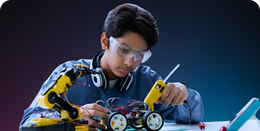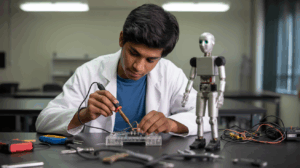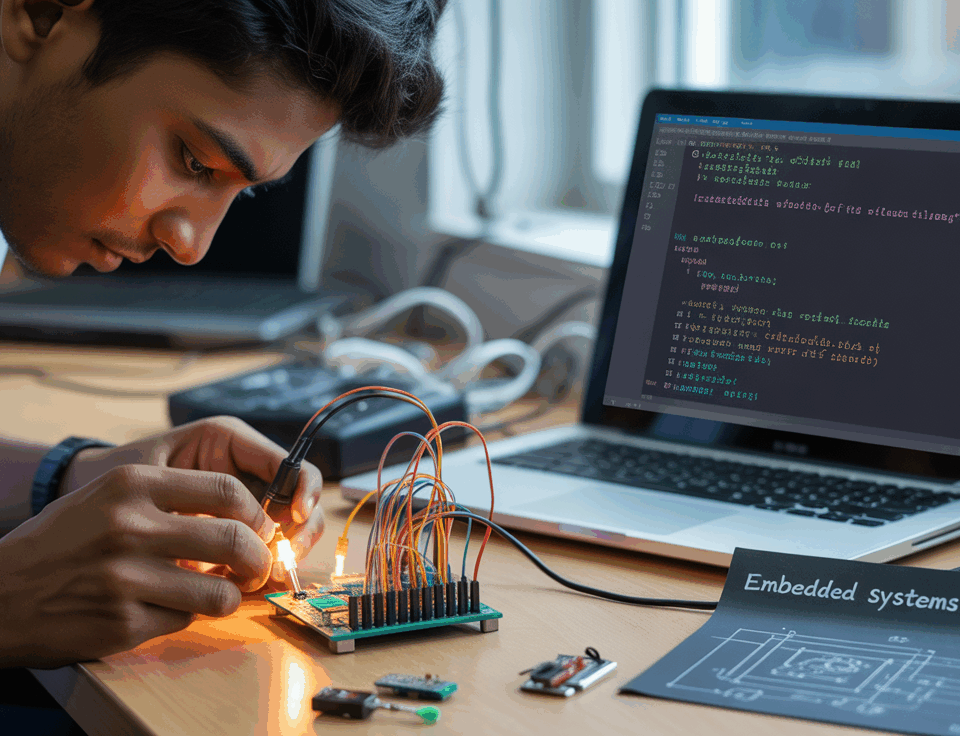
The Engineer’s Toolkit: Why PIC Microcontrollers Are Your Next Essential Skill
September 24, 2025
The Convergence Engine: Future Trends in Embedded Systems, IoT & Robotics (2025–2030)
December 3, 2025The global landscape of technology is evolving at an unprecedented pace, driven primarily by the advancements in automation and artificial intelligence. At the heart of this revolution lies robotics for students, a field that is no longer a niche elective but a foundational necessity for future engineers, innovators, and problem-solvers.
The journey into this dynamic discipline offers more than just technical knowledge; it provides a comprehensive skillset encompassing critical thinking, interdisciplinary collaboration, and practical application. For any ambitious student seeking to secure a powerful career in the core technology sector, mastering robotics for students is the critical first step. It is a curriculum that prepares one not just for the jobs of today, but for the engineering challenges that are yet to emerge.
This expansive guide delves deep into the educational significance of robotics for students, exploring the essential concepts, the learning methodologies that drive success, and the specific pathways offered by leading institutions like Elysium Embedded School. We will explore how dedicated programs transform theoretical understanding into tangible, working systems, ensuring that robotics for students becomes a cornerstone of their academic and professional development. The demand for graduates proficient in robotics for students is skyrocketing, making focused, high-quality training absolutely essential.
Table of Contents
The Educational Revolution: Why Robotics is Critical for Students
Modern education is continually challenged to prepare young minds for a world dominated by automation. Robotics for students offers the perfect solution, acting as a dynamic, project-based curriculum that fuses abstract theory with tangible results. It provides a unique educational framework where science, mathematics, computer science, and engineering principles are all simultaneously applied to solve real-world problems. When a student builds a robot that successfully navigates a maze, they are not just engaging in a fun activity; they are validating their understanding of physics, geometry, control theory, and algorithmic design. This integrated learning approach is what makes training in robotics so much more effective than traditional isolated instruction.
Cultivating Interdisciplinary Skills
The process of designing and debugging a robot inherently cultivates a suite of twenty-first-century skills essential for any professional career. It is an exercise in complex, sustained problem-solving.
-
Computational Thinking: Learning to write firmware for a robot requires translating a high-level goal (e.g., “pick up the box”) into a low-level sequence of logical commands and state machine diagrams. This practice is the core of computational thinking, enabling students to decompose vast problems into manageable, solvable components—a skill that extends far beyond the robot lab.
-
Resilience and Debugging: In robotics, failure is inevitable, but it is also the best teacher. When a robot malfunctions, students are forced to systematically troubleshoot—testing sensors, checking code logic, and verifying circuit integrity. This iterative process fosters resilience and a structured, analytical mindset, which is crucial for careers in embedded development and automation.
The STEM Integration Power
Robotics serves as the ultimate integrator of Science, Technology, Engineering, and Mathematics. A fundamental module in robotics for students often involves motion control. To regulate a motor’s speed precisely, the student must apply mathematical concepts (calculus for speed and acceleration), physics (torque and inertia), and programming (a proportional-integral-derivative, or PID, controller). This practical application deepens comprehension, transforming abstract equations into functional, observable reality.
The emphasis is placed firmly on hands-on execution. Without the ability to interface motors, actuators, and sensors correctly, the software remains useless. This mandatory harmony between hardware and software is what sets a curriculum focused on robotics apart, ensuring graduates possess a truly holistic engineering skill set.
Elysium Embedded School: The Focused Path for Robotics for Students
While many universities offer introductory robotics electives, specialized institutions like Elysium Embedded School provide an immersive, industry-aligned ecosystem dedicated entirely to embedded systems and automation. This laser focus ensures that their programs in robotics for students are not merely theoretical but are centered on achieving professional competency and job readiness. EES positions itself as a premier hub, particularly excelling at bridging the gap between academic knowledge and the real-time demands of the industry.
The Embedded Systems Foundation
A robot is, at its core, a sophisticated embedded system that interacts with the physical world. Therefore, truly advanced training in robotics for students must begin with mastery of the embedded layer. Elysium Embedded School’s curriculum is deliberately built upon a strong foundation of microcontroller architectures, including 8051, ARM, AVR, STM, and the application of development boards like Arduino and Raspberry Pi.
-
Low-Level Control: Students learn Embedded C programming, enabling them to directly interface with hardware registers, manage interrupts, and control peripherals. This low-level understanding is critical, as it ensures that the student can squeeze maximum performance and deterministic timing out of the robotic system—a professional requirement in any high-performance application of robotics.
-
RTOS Implementation: For complex, multitasking robots (like automated drones or industrial arms), the ability to manage real-time constraints is essential. EES’s training includes Real-Time Operating Systems (RTOS), which teaches robotics for students how to prioritize critical tasks, manage resources effectively, and ensure predictable behavior in mission-critical applications.
Progressive and Specialized Robotics Courses for Students
The school offers a highly structured learning path, ensuring every student progresses logically from foundational knowledge to expert capability. The courses are tailored to meet diverse learning objectives:
-
Core Level Robotics: Introduces fundamental concepts of robot anatomy, basic electronics, and elementary programming for motion and sensing, typically utilizing platforms like Arduino for quick prototyping.
-
Advanced and Expert Levels: Escalates complexity to include advanced kinematics, sensor fusion, wireless communication protocols, and the integration of powerful systems like the Raspberry Pi for vision and AI applications. This advanced training is designed to mold a competent robotics engineer.
-
Specialized Programs (ElectROBOT, Robotronics, Nenotronics): EES also caters to various levels and focus areas. ElectROBOT introduces younger learners to basic circuits and robotics principles. Robotronics focuses on the vital mechanical-electronic integration (Mechatronics), while Nenotronics delves into miniaturized and specialized embedded designs. This multi-track approach ensures quality instruction in every area of robotics.
Real-Time Lab Access and Mentorship
The success of any program focused on robotics for students hinges on practical, hands-on experience. EES prioritizes this through:
-
Real-Time Lab Access: Students are given access to equipped laboratories and hardware platforms, allowing them to instantly test and debug their code on live hardware. This eliminates the guesswork often associated with purely theoretical or simulation-based courses.
-
One-on-One Mentoring: Certified, industry-experienced trainers provide personalized guidance, helping students navigate the complex intersections of hardware, software, and physical mechanics. This expert support accelerates the learning curve significantly.
Deconstructing the Curriculum: Technical Deep Dive for Robotics for Students
To truly master the field, robotics for students must delve into the technical core of mechanical design, control theory, and high-level programming. The curriculum at Elysium Embedded School is designed to ensure technical competency in all these integrated domains.
Kinematics and Actuation Systems
The mechanical design is the skeleton and muscles of the robot. Without a robust physical system, the most sophisticated code is meaningless.
-
Robot Kinematics: Advanced robotics for students learn the mathematical models that govern robot movement. They study Forward Kinematics (calculating the end-effector position based on joint angles) and Inverse Kinematics (determining the joint angles needed to reach a specific target position). These calculations are foundational for industrial robotic arms and complex manipulators.
-
Motion Control Theory: Students must master the control systems that govern velocity, position, and torque. This involves applying closed-loop feedback mechanisms, such as PID control, to ensure that the robot’s motion is precise, stable, and deterministic, regardless of external forces or internal variations.
Sensing, Perception, and Computer Vision
A robot needs to perceive its environment to act intelligently. The curriculum for robotics for students emphasizes deep sensor integration.
-
Sensor Fusion: Rather than relying on a single sensor, sophisticated robots combine data from multiple sources (e.g., encoders, accelerometers, gyroscopes, and ultrasonic sensors) to create a more accurate and robust picture of their state. This process of sensor fusion is a critical topic.
-
AI and Computer Vision: The Expert Level training introduces robotics for students to the use of powerful single-board computers (like Raspberry Pi) running Embedded Linux, enabling them to implement computer vision algorithms using libraries like OpenCV. This allows the robot to perform object recognition, track items, and navigate complex environments, moving beyond simple distance sensing to true environmental perception. This is the cutting edge of applied robotics.
The Power of Embedded C and Python for Robotics
The code a student writes must be efficient, fast, and reliable. The training ensures proficiency in the languages that drive the industry.
-
Embedded C Proficiency: The vast majority of real-time systems and microcontrollers rely on Embedded C. The program for robotics for students ensures fluency in writing optimized, bare-metal code for managing peripherals, interrupts, and power consumption, which is critical for making robots reliable and energy-efficient.
-
Python for High-Level Tasks: While C handles the critical core, Python is utilized for its speed of development in high-level applications, such as machine learning implementation, cloud data logging, and running the graphical user interface (GUI) or dashboard for the robot. The ability to seamlessly integrate both C and Python code is a highly valued skill for any professional in robotics.
Career Pathways: The Future Awaits Graduates of Robotics for Students Programs
The investment in specialized training directly translates into high-demand career prospects. Graduates who excel in robotics for students programs are sought after in virtually every modern industry due to the convergence of automation, embedded systems, and AI.
Job-Assured Excellence and Placement Focus
Institutions like Elysium Embedded School focus on creating job-ready professionals. Their specialized REMO (Job Assured Courses) are a testament to this commitment, ensuring the curriculum aligns directly with the hiring needs of core technology companies.
-
Targeted Roles: Graduates are prepared for roles such as: Robotics Engineer, Embedded Systems Developer, Firmware Architect, Mechatronics Specialist, and Automation Solutions Architect.
-
Portfolio Building: The emphasis on project-based learning means that every student completes their program with a robust portfolio of functional, complex robot systems. This tangible proof of skill is the most powerful credential when applying for technical roles in the robotics industry. The specialized knowledge in microcontrollers and RTOS gives these graduates a distinct competitive advantage in the job market.
The Role in the IoT and Automation Ecosystem
The skills acquired through training in robotics for students are foundational to the Industrial Internet of Things (IIoT). Modern robots are not just isolated machines; they are network endpoints.
-
Connected Robotics: Students learn how to integrate robots with cloud platforms using protocols like MQTT, enabling remote diagnostics, predictive maintenance, and coordinated fleet management. This expertise places graduates at the forefront of smart manufacturing and large-scale industrial automation.
-
Pioneering Automation: From surgical robots in healthcare to autonomous delivery vehicles, the core principles taught in robotics for students—precision control, sensor integration, and real-time processing—are the drivers of all future automation technologies. A student equipped with this knowledge is prepared to innovate and lead in an ever-automating world.
Getting Started: Practical Advice for Aspiring Robotics for Students
For anyone looking to begin their journey, selecting the right training program is paramount. Look for one that provides structured progression, from basic concepts to advanced, job-oriented expertise.
-
Start with Foundational Platforms: While the ultimate goal may be complex AI-driven robots, starting with accessible platforms like Arduino is a great entry point for new learners. This helps build foundational confidence in electronics and programming before moving to more complex systems like Raspberry Pi, which is essential for advanced courses.
-
Embrace the Build Process: The best advice for any aspiring participant is to prioritize the physical creation and troubleshooting of systems. Theory is important, but true mastery in robotics for students comes from hours spent debugging a physical circuit, optimizing motor output, and refining algorithmic logic on a functioning prototype.
Frequently Asked Questions
1: Is a background in coding or electronics required before enrolling in a Core Level Robotics Course?
No. Courses in robotics for students, especially the Core Level, are designed to be beginner-friendly. They systematically introduce foundational concepts like basic programming logic (Embedded C) and fundamental electronics (circuits, components) from scratch, ensuring that any motivated student can begin their journey into robotics for students.
2: How does the Elysium Embedded School focus on Embedded Systems benefit students interested in robotics?
Robotics is fundamentally an application of embedded systems. EES’s training in core microcontrollers (ARM, STM), embedded C programming, and RTOS (Real-Time Operating Systems) provides a deep, industry-level foundation that goes beyond basic robotics kits, equipping robotics for students to design and program the robot’s “brain” efficiently and reliably.
3: What types of hands-on projects can a student expect to complete during the advanced Robotics for Students programs?
Advanced robotics for students projects move beyond simple line followers to complex systems such as robotic manipulators with inverse kinematics, surveillance robots with computer vision (using OpenCV and Raspberry Pi), autonomous navigation systems, and industrial automation prototypes utilizing IoT connectivity.
4: Does completing a course in robotics for students lead to job placement assurance?
Yes, institutions like Elysium Embedded School offer specialized, job-assured courses (REMO) that are explicitly tailored to industry needs. They provide dedicated placement assistance, including interview preparation and access to a network of hiring partners, specifically aiming to place robotics for students graduates in core technology and embedded roles.
5: What is the difference between the ElectROBOT program and the Core Level Robotics Course for students?
The ElectROBOT program is typically designed for younger or high school robotics for students (Junior Level), offering an interactive introduction to circuits and basic concepts. The Core Level Robotics Course is a more intensive, professional-track program aimed at college students and graduates, providing the necessary depth in embedded C and microcontroller interfacing for a career in robotics for students.
Conclusion: Securing the Future with Robotics for Students
The future is automated, interconnected, and intelligent, and the engineers who will build it are those who have mastered robotics for students today. The value proposition of a dedicated, immersive education in this field is clear: it fosters critical thinking, integrates complex scientific disciplines, and directly translates into high-demand career opportunities across the globe.
By choosing a focused path at an institution like Elysium Embedded School, students gain not just certifications, but real-world proficiency in microcontrollers, RTOS, and advanced control systems. The journey into robotics for students is a commitment to a lifelong skill set that is both personally fulfilling and professionally lucrative. For any student aiming to be at the vanguard of the next technological wave, the time to commit to mastering robotics for students is now. The comprehensive training and practical exposure ensure that every graduate is ready to step into the world and engineer a truly remarkable tomorrow.
Ultimately, the mastery of robotics for students is about engineering the future itself. It is the power to translate an idea into intelligent, autonomous reality, and it positions the individual at the vanguard of the automation revolution. For those ready to move past passive learning and take control of their career trajectory, embracing this rigorous, hands-on path is the definitive call to action. The architects of the next generation of intelligent machines are being trained today; their success will define the technological landscape of tomorrow.













